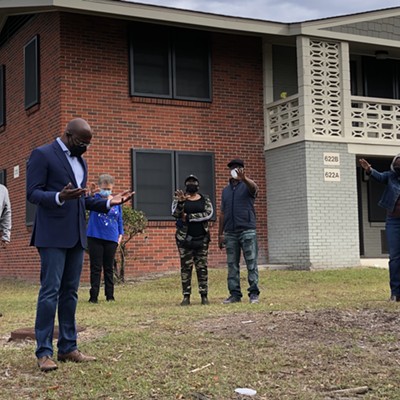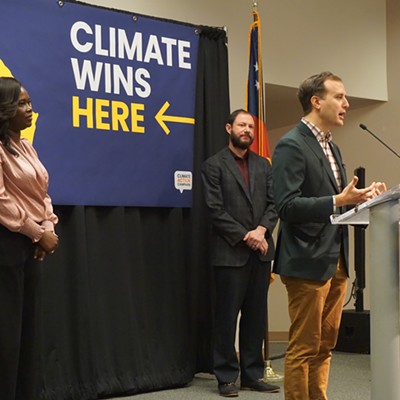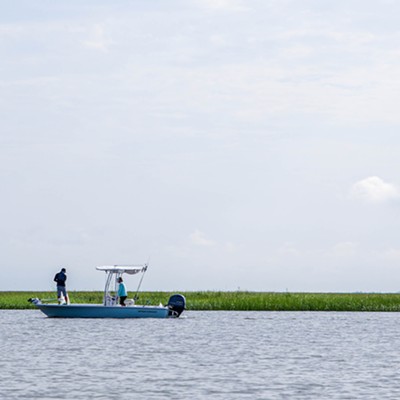Dr. David Hurst Thomas is the curator of North American Archaeology with the American Museum of Natural History, and while he's worked on sites around the country, the one he's spent the most time researching is St. Catherine's Island, a barrier island about 50 miles south of Savannah.
Since setting out to discover the long lost Spanish mission that had been established on the island in the 16th Century, Thomas has spent much of the last 36 years on the island, excavating the mission site, as well as several Native American sites that are several thousand years old, discovering more than 1 million artifacts that were recently made part of the collection of the Fernbank Museum in Atlanta.
On Wednesday, November 10, Thomas will give a free talk at the Coastal Georgia Center at 10:30 a.m., discussing his extensive research on the island. We caught up with him by phone last week to talk about his work, the threat of erosion, and whether there's anything left to discover on the island.
With a million objects sent to the Fernbank Museum and decades of work done out on the island, is there anything left to dig up?
Dr. Thomas: Absolutely. With all of the global climate change that's going on now, and has been going on for thousands of years at different rates, the island is heavily impacted by sea level change and the erosion here is as epic as anything we're seeing along the eastern seaboard.
What that means for the archaeology is that we're losing archaeological sites at a record clip. We can't stop the erosion but what we can do is save some of that information. We have a crew out on middle beach as we speak, which is about the most remote part of St. Catherine's, right on the Atlantic front. We're losing a site that was occupied between 1200 years ago and about 600 years ago. A whole pot washed out of there this summer. What we're trying to do is mitigate the impact, otherwise that site won't be there in a couple of years. That's part of our conservation effort is trying to salvage as much of the information about the past as we can over here.
In terms of research, we spent years working on finding the long lost Spanish mission over here. It's the earliest European settlement in Georgia. It was abandoned in 1680 and then lost for 300 years. It took us 5 years to find it and then we excavated there for 15 years. All of that material has gone to Fernbank and we're in the process of writing a couple of books about it now. The mission itself, we've barely scratched the surface. We've dug less than 1 percent of it.
About five or six years ago, we started a full bore research program again, and we focused on two things. One is the very oldest pottery in North America, which occurs here on St. Catherine's and on some of the other sea islands and up the Savannah River. We spent about five years of research exploring these two really old late archaic sites. They're comprised of artificial rings of shell. They're about 70 meters across and they stand about waist high. They're perfect circles that were built between 4,000-5,000 years ago. We have no idea how they were built or why they were built. We've been doing extensive archaeological research on these. It's certainly the oldest pottery. It's also one of the earliest architectural expressions in North America. There are lots of puzzles with that.
The second focus is moving to the late pre-historic period, trying to figure out who are the Indians that greeted Menendez and the other Spanish from St. Augustine when they arrived in Georgia. We have a town settlement that was certainly occupied in the 1560s when the Spanish showed up and was occupied about 300 years before that. We started excavating there in 1975, but we've gotten very serious about it and the town structure.
A lot of what we do is try to perfect the technology of archaeology over here because we can take our time and there's not going to be a Shoney's built on any of these sites any time soon. The land is protected so we can take our time and do experimental work. That's what keeps us busy over here. There was a bit of an impression that once we located the mission, which is a pretty spectacular site, and an important place in Georgia history, there was a feeling that St. Catherine's was sort of a sucked orange. Clearly, that's not the case. We've documented over 200 archeological sites over here. We know, because of the random sampling, there are between 600-700. There are hundreds of sites that are out there that we haven't even found yet.
How much time are you able to spend on the island and is that enough time?
Dr. Thomas: We spend 2-3 months per year here. We have our full bore excavations, something we've been doing for three dozen years, where it makes sense for us for three weeks or a month. When we were digging the mission we were here six or seven months a year. That's hard to maintain. It's better for us. For every day we spend in the field, it takes us about a week in the lab, so it gives us a chance to go back, process some of the lab stuff, and when we come back we're up to date, we know what we found last time and we know where to focus. It's an ideal set up.
With the storm surge, the erosion and other encroachment, it sounds like this is a race against time. Is there going to be a point when erosion will have done the worst it can do and the sites will stabilize, or is this an ongoing ever-worsening situation?
It will continue to be ongoing. The nine major sea islands along the coast of Georgia were really a quirk of sea level change. Part of them formed during the Ice Age. The terrestrial part has stable soil and mature maritime forests. The barrier island part has been added in the last 10,000 years and these are kind of in equilibrium with the tides. It's that old part of the island that makes that unique and really made them attractive to the native people who lived here. We know from our regional work here, there are archaeological sites everywhere on the island, so if there's erosion anywhere on the island at all, it's taking out sites. What's unusual here is we're eroding the old part of the island, not just the more recent accumulation. What that means is, we're losing, systematically, the oldest sites on the island. The one out on Middle Beach that I mentioned is unusual, it's a later site, but it's in a precarious spot. The mission is another exception, but usually we're losing sites that are 3,000-5,000 years old, which are because they're so old to begin with. There's no reason to think erosion is going to abate. Part of it has to do with global climate situations. Part of it has to do with sediment supplies on the Savannah River. We can model it however we want, but I don't think it's going to stop.
With the sediment supplies along the river, and this is a little off topic, but one of the important discussions up here is the dredging of the river to allow larger cargo ships access to the port. Is that dredging removing some of the sediments that would be replenishing those beach stores?
Dr. Thomas: Yeah, among other issues. I'm involved with a National Science Foundation project about a post-Katrina event where we're looking at the various barrier islands and what can be done in a Northern Hemisphere sense. The Corps of Engineers spends a lot of time trying to stabilize beaches, like on Tybee and different places.
It's such a complex mix of what is environmental and what is land management use, dredging and that sort of thing. They feed back on each other with the apparent human hand involved in global climate change. We've had global climate change since there's been a Georgia coast, but in this case, apparently accelerating things. There's also a change in storm patterns. If you take the long term perspective, say 5,000 years, which is how long people have lived on St. Catherine's, the first 1,000 years was about like it is today, where you can expect maybe a couple of hurricanes every century to come ashore. Then, from 4,000 years ago there were five times as many category four and five hurricanes striking the Georgia coast, so over the last 1,000 years, we've been back to a period of just a few storms per century. There's some indication that that's going up again, and we're going back to the old pattern of serious storm activity. That's one thing we're monitoring with the geological record here. We do a great deal of geological research to see if we can't find something about the changing frequency of these storms making landfall, which has huge impacts on people. The storm that killed 2,000 people in Savannah in the late 1890s is one example.
Are these environmental effects, because the island is secure, are they the biggest challenge you have to your archaeological work there or are there other obstacles and hindrances?
Dr. Thomas: I'd reverse that a little bit. St. Catherine's, because of the way it's been managed over the past several decades, it has an archaeological record that is preserved in a way you don't see on any of the other Sea Islands in Georgia. It's the only privately owned island now. It's basically not had to make a living since the war between the States. The land has not been harmed. Not many trees have been removed. We've got a big leg up on things that have been preserved here that have not been preserved in other places. The second part is, because there's no development going on here, the sites are not being destroyed. We can preserve them that way. By default, it means the biggest threats are environmental because the other threats have been removed.



























